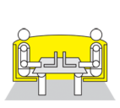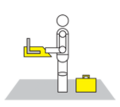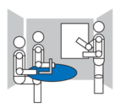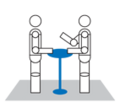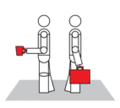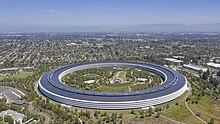
A desk or bureau is a piece of furniture with a flat table-style work surface used in a school, office, home or the like for academic, professional or domestic activities such as reading, writing, or using equipment such as a computer. Desks often have one or more drawers, compartments, or pigeonholes to store items such as office supplies and papers. Desks are usually made of wood or metal, although materials such as glass are sometimes seen.

A cubicle is a partially enclosed office workspace that is separated from neighboring workspaces by partitions that are usually 5–6 feet (1.5–1.8 m) tall. Its purpose is to isolate office workers and managers from the sights and noises of an open workspace so that they may concentrate with fewer distractions. Cubicles are composed of modular elements such as walls, work surfaces, overhead bins, drawers, and shelving, which can be configured depending on the user's needs. Installation is generally performed by trained personnel, although some cubicles allow configuration changes to be performed by users without specific training.
A virtual office is part of the flexible workspace industry that provides businesses with any combination of services, space and/or technology, without those businesses bearing the capital expenses of owning or leasing a traditional office.
Hot desking is a work office organization system where each space is available for any worker, rather than reserved for a specific worker, so different workers may use the same spot along the day or week. The "desk" in the name refers to a table or other work space being shared by multiple workers on different shifts as opposed to every staff member having their own personal desk. A primary motivation for hot-desking is cost reduction through space savings—up to 30% in some cases. Hot desking is especially valuable in cities where real estate prices are high.
SteelcaseInc. is an international manufacturer of furniture, casegoods, seating, and storage and partitioning systems for offices, hospitals, classrooms, and residential interiors. It is headquartered in Grand Rapids, Michigan, United States.
Hoteling is a method of office management in which workers dynamically schedule their use of workspaces such as desks, cubicles, and offices. It is an alternative approach to the more traditional method of permanently assigned seating. Hoteling is reservation-based unassigned seating; employees reserve a workspace before they come to work in an office. An alternate method of handling unassigned seating is hot desking, which does not involve reservations; with hot-desking, a worker chooses a workspace upon arrival, rather than reserving it in advance. The use of the term has declined in recent years.
The Action Office is a series of furniture designed by Robert Propst, and manufactured and marketed by Herman Miller. First introduced in 1964 as the Action Office I product line, then superseded by the Action Office II series, it is an influential design in the history of "contract furniture". The Action Office II series introduced the concept of the flexible, semi-enclosed workspaces, now better known as the cubicle. All cubicle office designs can be traced back to Herman Miller's Action Office product lines.
A virtual workplace is a work environment where employees can perform their duties remotely, using technology such as laptops, smartphones, and video conferencing tools. A virtual workplace is not located in any one physical space. It is usually a network of several workplaces technologically connected without regard to geographic boundaries. Employees are thus able to interact in a collaborative working environment regardless of where they are located. A virtual workplace integrates hardware, people, and online processes.
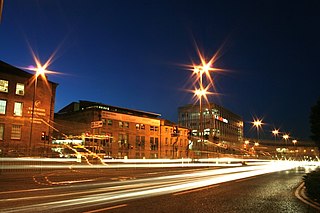
The Media Centre is a business centre and a community of digital, media and creative and supporting industry businesses in the West Yorkshire town of Huddersfield, England, with 65 managed office spaces and Flex, a dedicated co-working and hot desk area for freelancers and remote workers. It offers flexible workspace solutions, Virtual Office packages and meeting room hire.
Sound masking is the inclusion of generated sound into an environment to mask unwanted sound. It relies on auditory masking. Sound masking is not a form of active noise control ; however, it can reduce or eliminate the perception of sound. Sound masking is applied to an entire area to improve acoustical satisfaction, thus improving the acoustical privacy of the space. This can help an individual focus and thereby enhance productivity.

Office landscape was an early (1950s) movement in open plan office space planning that typically used irregular geometry and organic circulation patterns.

Open plan is the generic term used in architectural and interior design for any floor plan that makes use of large, open spaces and minimizes the use of small, enclosed rooms such as private offices. The term can also refer to landscaping of housing estates, business parks, etc., in which there are no defined property boundaries, such as hedges, fences, or walls.

Coworking is an arrangement in which workers for different companies share an office space. It allows cost savings and convenience through the use of common infrastructures, such as equipment, utilities and receptionist and custodial services, and in some cases refreshments and parcel acceptance services. It is attractive to independent contractors, independent scientists, remote workers, digital nomads, and people who travel frequently. Additionally, coworking helps workers avoid the feeling of social isolation they may experience while remote working or traveling and eliminate distractions in home office. Most coworking spaces charge membership dues. Major companies that provide coworking space and serviced offices include WeWork, IWG plc, Industrious, and Impact Hub.

A room divider is a screen or piece of furniture placed in a way that divides a room into separate areas. Room dividers are used by interior designers and architects as means to divide space into separate distinct areas.

The Schiappa Library is a public library located in Steubenville, Ohio. It is a branch of the Public Library of Steubenville and Jefferson County (PLSJ), which services a large area in southeast Ohio – otherwise known as the Ohio Valley. Besides the Schiappa Library, PLSJ has branches all over Jefferson County, Ohio located in Toronto, Brilliant, Tiltonsville, Dillonvale and Adena with the Main Library located in Steubenville. The Schiappa branch is located at the west end of Steubenville on the Fort Steuben Mall property. It not only serves as an additional library for the city of Steubenville, but also as a library for the neighboring village of Wintersville, Ohio.

Office space planning is the process of organizing the workplace layout, furniture and office functions to work effectively together, while using space efficiently. Floor plans should consider the workgroup function, building codes and regulations, lighting, teaming requirements, inter-communication and storage, as well as zoning for employee workstations, task space needs, support rooms and reception areas to make the best use of available space. Optimising office spaces with effective space planning can aid circulation, productivity and improve workplace wellness, as well as the health and safety of occupants.
Interior design psychology is a field within environmental psychology, which concerns the environmental conditions of the interior. It is a direct study of the relationship between an environment and how that environment affects the behavior of its inhabitants, intending to maximize the positive effects of this relationship. Through interior design psychology, the performance and efficiency of the space and the well-being of the individual are improved. Figures like Walter Benjamin, Sigmund Freud, John B. Calhoun and Jean Baudrillard have shown that by incorporating this psychology into design one can control an environment and to an extent, the relationship and behavior of its inhabitants. An example of this is seen through the rat experiments conducted by Calhoun in which he noted the aggression, killing and changed sexual tendencies amongst rats. This experiment created a stark behavioral analogy between the rat's behavior and inhabitation in high-rise building projects in the US after WWII, an example of which is the Pruitt-Igoe development in St Louis demolished in 1972 only 21 years after being erected.
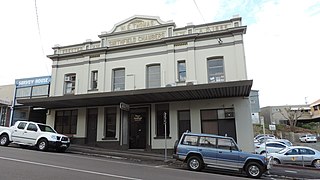
Smithfield Chambers is a heritage-listed office building at 235 Mary Street, Gympie, Gympie Region, Queensland, Australia. It was designed by Leslie Gordon Corrie and built in the 1890s by William Anthony. It was added to the Queensland Heritage Register on 15 July 2011.

Learning space or learning setting refers to a physical setting for a learning environment, a place in which teaching and learning occur. The term is commonly used as a more definitive alternative to "classroom," but it may also refer to an indoor or outdoor location, either actual or virtual. Learning spaces are highly diverse in use, configuration, location, and educational institution. They support a variety of pedagogies, including quiet study, passive or active learning, kinesthetic or physical learning, vocational learning, experiential learning, and others. As the design of a learning space impacts the learning process, it is deemed important to design a learning space with the learning process in mind.
Activity-based working (ABW) is an organizational strategic framework that recognizes that people often perform a variety of activities in their day-to-day work, and therefore need a variety of work settings supported by the right technology and culture to carry out these activities effectively. Based on activity, individuals, teams, and the organization are empowered to achieve their full potential by developing a culture of connection, inspiration, accountability, and trust. On a personal level, ABW also enables each person to organize their work activities in a way that best suits what and with whom they are trying to accomplish, promoting productivity and engagement at work. Although not normally implemented as a cost-saving business strategy, it can produce efficiencies and cost savings through more effective collaboration and team work. Inspiring spaces that evolve from an activity-based approach are designed to create opportunities for a variety of workplace activities, ranging from intense focused work to collaboration, as well as areas for meetings, whether formal or impromptu.














